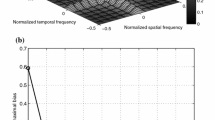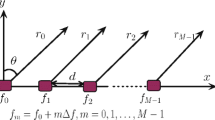Abstract
In frequency diverse array (FDA) space–time adaptive processing (STAP) system, the spectrum of fast-moving target is non-well focused in the spatial–temporal plane, which causes a large mismatch between the actual and presumed target steering vector and dramatically degrades the performance of FDA-STAP system. In this paper, we propose a robust FDA-STAP approach based on multiple possible prior information constraints to resolve this issue and improve the performance of FDA-STAP system. In the proposed approach, multiple possible prior information, i.e., multiple large uncertainty regions, where the actual target possibly locate in spatial–temporal domains, are utilized to cover and constraint the estimated steering vector. The multiple uncertainty regions constraints make it possible to accurately estimate the fast-moving target steering vector. Moreover, to mitigate the influence of non-focused spatial–temporal spectrum of fast-moving target, a non-focused constraints is developed using the squared norm of space–time steering vector to avoid the estimated steering vector converge to the non-focused region of fast-moving target. Finally, the proposed robust FDA-STAP is converted into a non-convex quadratically constrained quadratic programming problem, and the semidefinite relaxation technique is employed to obtain the estimated target steering vector. Numerical results indicate that the proposed method has superior performance than other methods, including well-maintained main beam direction and significant performance improvement.











Similar content being viewed by others
Notes
The fast-moving target is usually Doppler ambiguous, and here we assumed that the Doppler ambiguity is resolved.
References
Antonik, P., Wicks, M. C., Griffiths, H. D., & Baker, C. J. (2006). Frequency diverse array radars. In Proceedings of the IEEE Radar Conference (pp. 215–217), Verona, NY, USA, April 2006.
Baizert, P., Hale, T. B., Temple, M. A., & Wicks, M. C. (2006). Forwardlooking radar GMTI benefits using a linear frequency diverse array. Electronics Letters, 42, 1311–1312.
Beck, A., & Eldar, Y. C. (2007). Doubly constrained robust Capon beamformer with ellipsoidal uncertainty sets. IEEE Transactions on Signal Processing, 55, 753–758.
Boyd, S., & Vandenberghe, L. (2004). Convex optimization. Cambridge: Cambridge Univ. Press.
Carlson, B. D. (1988). Covariance matrix estimation errors and diagonal loading in adaptive arrays. IEEE Transactions on Aerospace and Electronic Systems, 24, 397–401.
Chen, C. Y., & Vaidyanathan, P. P. (2007). Quadratically constrained beamforming robust against direction-of-arrival mismatch. IEEE Transactions on Signal Processing, 55, 4139–4150.
Elnashar, A. (2008). Efficient implementation of robust adaptive beamforming based on worst-case performance optimization. IET Signal Processing, 2, 381–393.
Feng, Y., Liao, G., Xu, J., Zhu, S., & Zeng, C. (2018). Robust beamforming using multiple constraints relaxation. In Proceedings 2018 IEEE 10th sensor array and multichannel signal processing workshop (SAM) (pp. 514–518), Sheffield, South Yorkshire, United Kingdom, July 2018.
Gao, K., Wang, W.-Q., Cai, J. Y., & Xiong, J. (2016). Decoupled frequency diverse array range-angle-dependent beampattern synthesis using nonlinearly increasing frequency offsets. IET Microwaves, Antennas & Propagation, 10, 880–884.
Gui, R., Wang, W.-Q., Cui, C., & So, H.-C. (2018). Coherent pulsed-FDA radar receiver design with time-variance consideration: SINR and CRB analysis. IEEE Transactions on Signal Processing, 66, 200–214.
Hassanien, A., Vorobyov, S. A., & Wong, K. M. (2008). Robust adaptive beamforming using sequential programming: An iterative solution to the mismatch problem. IEEE Signal Processing Letters, 15, 733–736.
Huang, J., Tong, K.-F., & Baker, C. J. (2008). Frequency diverse array with beam scanning feature. In Proceedings of the international symposium on IEEE antennas and propagation (pp. 1–4), San Diego, CA, USA, July 2008.
Huang, J., Tong, K. F., & Baker, C. (2009). Frequency diverse array: Simulation and design. In Proceedings loughborough antennas and propagation conference (pp. 253–256), Loughborough, UK, November 2009.
Khabbazibasmenj, A., Vorobyov, S. A., & Hassanien, A. (2012). Robust adaptive beamforming based on steering vector estimation with as little as possible prior information. IEEE Transactions on Signal Processing, 60, 2974–2987.
Khan, W., & Qureshi, I. M. (2014). Frequency diverse array radar with time-dependent frequency offset. IEEE Antennas and Wireless Propagation Letters, 13, 758–761.
Khan, W., Qureshi, I. M., Basit, A., & Khan, W. (2016). Range-bins-based MIMO frequency diverse array radar with logarithmic frequency offset. IEEE Antennas and Wireless Propagation Letters, 15, 885–888.
Khan, W., Qureshi, I. M., & Saeed, S. (2015). Frequency diverse array radar with logarithmically increasing frequency offset. IEEE Antennas and Wireless Propagation Letters, 14, 499–502.
Klemm, R. (2006). Principles of space–time adaptive processing (3rd ed.). London: IET.
Li, Q., Liao, B., Huang, L., Guo, C., Liao, G., & Zhu, S. (2016). A robust STAP method for airborne radar with array steering vector mismatch. Signal Processing, 128, 198–203.
Li, J., Stoica, P., & Wang, Z. (2003). On robust Capon beamforming and diagonal loading. IEEE Transactions on Signal Processing, 51, 1702–1715.
Li, J., Stoica, P., & Wang, Z. (2004). Doubly constrained robust Capon beamformer. IEEE Transactions on Signal Processing, 52, 2407–2423.
Liao, B., Tsui, K. M., & Chan, S. C. (2011). Robust beamforming with magnitude response constraints using iterative second-order cone programming. IEEE Transactions on Antennas and Propagation, 59, 3477–3482.
Liu, Y. M., Hang, R., Wang, L., & Nehorai, A. (2017). The random frequency diverse array: A new antenna structure for uncoupled direction-range direction in active sensing. IEEE Journal of Selected Topics in Signal Processing, 11, 295–308.
Luo, Z. Q., Ma, W. K., So, A. M. C., Ye, Y., & Zhang, S. (2010). Semidefinite relaxation of quadratic optimization problems. IEEE Signal Processing Magazine, 27, 20–34.
Melvin, W. L. (2004). A STAP overview. IEEE Aerospace and Electronic Systems Magazine, 19, 19–35.
Qin, S., Zhang, Y. D., Amin, M. G., & Gini, F. (2017). Frequency diverse coprime arrays with coprime frequency offsets for multitarget localization. IEEE Journal of Selected Topics in Signal Processing, 11, 321–335.
Reed, I. S., Mallett, J. D., & Brennan, L. E. (1974). Rapid convergence rate in adaptive arrays. IEEE Transactions on Aerospace and Electronic Systems, 10, 853–863.
Sammartino, P. F., & Baker, C. J. (2009). Developments in the frequency diverse bistatic system. In Proceedings IEEE radar conference (pp. 1–5), Pasadena, CA, USA, May 2009.
Sammartino, P. F., Baker, C. J. and Griffiths, H. D. (2010). Range-angle dependent waveform. In Proceedings IEEE radar conference (pp. 511–515), Ispra, Italy, May 2010.
Sammartino, P. F., Baker, C. J., & Griffiths, H. D. (2013). Frequency diverse MIMO techniques for radar. IEEE Transactions on Aerospace and Electronic Systems, 49, 201–222.
Secmen, M., Demir, S., Hizal, A., & Eker, T. (2007). Frequency diverse array antenna with periodic time modulated pattern in range and angle. In Proceedings IEEE radar conference (pp. 427–430), Piscataway, NJ, USA, April 2007.
Shao, H., Dai, J., Xiong, J., Chen, H., & Wang, W.-Q. (2016). Dot-shaped range-angle beampattern synthesis for frequency diverse array. IEEE Antennas and Wireless Propagation Letters, 15, 1703–1706.
Vorobyov, S. A., Chen, H., & Gershman, A. B. (2008). On the relationship between robust minimum variance beamformers with probabilistic and worst-case distrortionless response constraints. IEEE Transactions on Signal Processing, 56, 5719–5724.
Vorobyov, S. A., Gershman, A. B., & Luo, Z. (2003). Robust adaptive beamforming using worst-case performance optimization: A solution to the signal mismatch problem. IEEE Transactions on Signal Processing, 51, 313–324.
Wang, C., Xu, J., Liao, G., Xu, X., & Zhang, Y. (2017). A range ambiguity resolution approach for high-resolution and wide-swath SAR imaging using frequency diverse array. IEEE Journal of Selected Topics in Signal Processing, 11, 336–346.
Wang, W.-Q. (2013). Phased-MIMO Radar with frequency diversity for range-dependent beamforming. IEEE Sensors Journal, 13, 1320–1328.
Wang, W.-Q., & Shao, H. (2014). Range-angle localization of targets by a double-pulse frequency diverse array radar. IEEE Journal of Selected Topics in Signal Processing, 8, 106–114.
Ward, J. (1994). Space-time adaptive processing for airborne radar. Lincoln Lab, MIT, Lexington, MA, USA, Tech. Rep. 1015.
Antonik P., Wicks, M. C., Griffiths, H. D., & Baker, C. J. (2006). Multimission multi-mode waveform diversity. In Proceedings of the IEEE radar conference (pp. 580–582), Verona, NY, USA, April 2006.
Xu, J., Liao, G., Huang, L., & So, H.-C. (2017). Robust adaptive beamforming for fast-moving target detection with FDA-STAP radar. IEEE Transactions on Signal Processing, 65, 973–984.
Xu, J., Liao, G., & So, H.-C. (2016). Space-time adaptive processing with vertical frequency diverse array for range-ambiguous clutter suppression. IEEE Transactions on Geoscience and Remote Sensing, 54, 5352–5364.
Xu, J., Liao, G., Zhu, S., & Huang, L. (2015a). Response vector constrained robust LCMV beamforming based on semidefinite programming. IEEE Transactions on Signal Processing, 63, 5720–5732.
Xu, J., Liao, G., Zhu, S., Huang, L., & So, H.-C. (2015b). Joint range and angle estimation using MIMO radar with frequency diverse array. IEEE Transactions on Signal Processing, 63, 3396–3410.
Xu, J., Liao, G., Zhu, S., & So, H.-C. (2015c). Deceptive jamming suppression with frequency diverse MIMO radar. Signal Processing, 113, 9–17.
Xu, J., Zhu, S., & Liao, G. (2015d). Range ambiguous clutter suppression for airborne FDA-STAP radar. IEEE Journal of Selected Topics in Signal Processing, 9, 1620–1631.
Xu, J., Zhu, S., & Liao, G. (2015e). Space-time-range adaptive processing for airborne radar systems. IEEE Sensors Journal, 15, 1602–1610.
Yao, A.-M., Rocca, P., Wu, W., Massa, A., & Fang, D.-G. (2017a). Synthesis of time-modulated frequency diverse arrays for short-range multi-focusing. IEEE Journal of Selected Topics in Signal Processing, 11, 282–294.
Yao, A.-M., Wu, W., & Fang, D.-G. (2016). Frequency diverse array antenna using time-modulated optimized frequency offset to obtain time-invariant spatial fine focusing beampattern. IEEE Transactions on Antennas and Propagation, 64, 4434–4446.
Yao, A.-M., Wu, W., & Fang, D.-G. (2017b). Solutions of time-invariant spatial focusing for multi-targets using time modulated frequency diverse antenna arrays. IEEE Transactions on Antennas and Propagation, 65, 552–566.
Yu, Z. L., Er, M. H., & Ser, W. (2008). A novel adaptive beamformer based on semidefinite programming (SDP) with constraints on magnitude response. IEEE Transactions on Antennas and Propagation, 56, 1297–1307.
Yu, Z. L., Gu, Z. H., Zhou, J. J., Li, Y. Q., Ser, W., & Er, M. H. (2010). Arobust adaptive beamformer based on worst-case semi-definite programming. IEEE Transactions on Signal Processing, 58, 5914–5919.
Yu, Z. L., Ser, W., Er, M. H., Gu, Z. H., & Li, Y. Q. (2009). Robust adaptive beamformers based on worst-case optimization and constraints on magnitude response. IEEE Transactions on Signal Processing, 57, 2615–2628.
Acknowledgements
This work was supported in part by the National Natural Science Foundation of China under Grant 61501501, Grant 61571459 and Grant 61501504. The authors would like to thank the editor and the anonymous reviewers for their insightful comments that improved the quality of the paper.
Author information
Authors and Affiliations
Corresponding author
Additional information
Publisher’s Note
Springer Nature remains neutral with regard to jurisdictional claims in published maps and institutional affiliations
Rights and permissions
About this article
Cite this article
Li, Z., Zhang, Y., Guo, Y. et al. A robust STAP approach for airborne FDA radar with multiple possible prior information constraints. Multidim Syst Sign Process 30, 2147–2166 (2019). https://doi.org/10.1007/s11045-019-00647-6
Received:
Revised:
Accepted:
Published:
Issue Date:
DOI: https://doi.org/10.1007/s11045-019-00647-6




